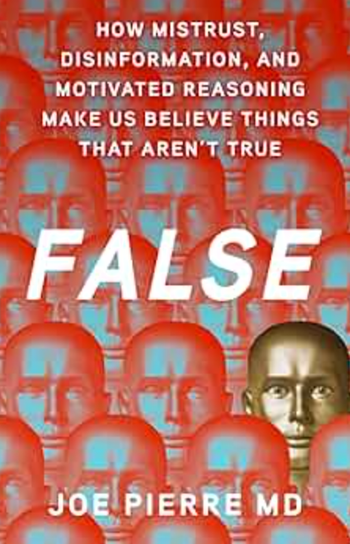
Critical Pluralism in Psychiatry and Mental Health
Awais Aftab, MD, explores the many aspects of psychiatry through engaging interviews that challenge traditional views and advocate for a more inclusive dialogue. Check out this review of his new book.
BOOK REVIEW
by Awais Aftab, MD; Oxford University Press, 2024
384 pages; $50.00 (paperback)
Reviewed by Jesus Ramirez-Bermudez, MD, PhD
Conversations in Critical Psychiatry by Awais Aftab, MD, offers a detailed examination of the philosophical, scientific, sociocultural, and ethical controversies in psychiatry and mental health. Presented as a series of interviews, the book is not an exercise of academic journalism in the traditional sense. Instead, it adopts a dialogical format with a polyphonic and intertextual texture. In each chapter, Aftab contextualizes the interviewee's work within broader debates in the philosophy of psychiatry—such as the political dimensions of mental health, its connection to human rights, and the importance of involving diverse societal sectors in developing an integrative model. Then, the dialogue unfolds gradually.
Like many clinicians working in mental health, I am aware of the significant challenges we face in everyday practice. While there are many success stories that offer genuine hope, there are also difficult outcomes that demand careful reflection. Researchers dedicated to the honest pursuit of knowledge recognize the gap between the harsh realities of clinical practice and the provisional nature of our scientific models. Bridging this gap requires a metatheoretical debate that acknowledges the diversity of thought and values within the field of mental health. As Kenneth S. Kendler, MD, points out, researchers and practitioners often operate with a set of implicit philosophical assumptions that remain unexamined.1 Unfortunately, the current debate is polarized by scholars at opposing ends of the academic spectrum: some entirely reject psychiatry, viewing it as useless—or even immoral and harmful—while others dismiss all criticism of psychiatric practice outright. Is it impossible to imagine an integration of the best critical trends into the theory and practice of psychiatry? Listening to divergent viewpoints is essential. Psychiatrists, just like critics of psychiatry and mental health professionals in the broader term, can fall into a vicious cycle typical of the digital age: I am referring to echo chambers, with their confirmation biases and tendencies toward recursive reinforcement.
During the COVID-19 pandemic, many of us followed Aftab’s interview series
A central part of the book focuses on the critical analysis of contemporary psychiatry, drawing on Anne Harrington, PhD’s historical perspective (The Structure of Psychiatric Revolutions) and the work of the British Critical Psychiatry Network. A key focus of this Network, as posed by Joanna Moncrieff, MD, relies on 2 questions: Are mental disorders truly illnesses in the medical sense, or are they “problems in living” that have been unjustifiably medicalized and pathologized? And do these disorders have biological causes, or should they be understood through psychological causality? The answers carry major implications, supporting the need for medical treatment or suggesting that such issues fall outside the scope of medicine. According to Duncan Double, MD, “the essential stance of critical psychiatry is that functional mental illness should not be reduced to brain disease... Functional mental illness is a personal experience that has no underlying brain pathology.” An example of this critical stance appears in Sami Timimi, MD’s interview, where he describes child psychiatry as a domain undergoing the “McDonaldization” of child development. This refers “to the way the challenges and uncertainties associated with growing up are placed into neat categories of things that are wrong with individual children, which can then be ‘fixed’ with simple, one-size-fits-all interventions. The market economy and culture prey on our desire for immediate satisfaction.”3
At times, the interviewees are defenders of the medical model of psychiatry. Their inclusion provides balance by presenting arguments in favor of key aspects of the discipline—diagnostic methods, taxonomy, the biopsychosocial framework, and the integration of biological and psychological interventions. In the chapters “The Battle for the Soul of Psychiatry,” “The Medical Model in Theory and Practice,” and “Psychiatry and the Long View,” Ronald W. Pies, MD; Paul Summergrad, MD; and Ahmed Samei Huda, MBChb, MSc, offer important clarification of the medical model, one that goes beyond the common caricature of psychiatry as a purely biomedical field indifferent to psychosocial factors. These authors highlight the field’s history, emphasizing efforts to integrate neuroscience, psychotherapy, and clinical reasoning within a rational framework shaped by clinical epidemiology.
The book also explores an internal critique of mainstream psychiatry, from psychiatrists themselves. Allen Frances, MD, warns of increasing overdiagnosis in the US of conditions such as bipolar II disorder, autism, and attention-deficit disorder, along with the overprescription of antidepressants for mild cases. Frances also stresses that patients with severe mental illness are neglected by American society, denied access to effective pharmacological treatment and funneled into the criminal justice system due to failures in public health care. Nassir Ghaemi, MD, MPH, postulates that most psychiatric medications are symptomatic treatments; few are truly disease-modifying (lithium for manic-depressive disease is a rare exception). He uses the term disease as the word disorder is scientifically vague from his perspective. According to Ghaemi, many psychiatrists are unwilling to accept the verdict of science regarding the efficacy of treatments, as opposed to their own wishes; the profession needs a self-critical attitude that submits to scientific judgement with humanistic sensitivity.
One of the book’s recurring themes is the nature of psychiatric constructs and their relationship to real clinical patterns. This ontological and epistemological debate is explored in conversations with Sam Fellowes, PhD (A Kantian Approach to Psychiatric Diagnosis); Giovanni Andrea Fava, MD (The Impoverishment of Psychiatric Knowledge); and Paul R. McHugh, MD (Explanatory Methods in Psychiatry). Most interviewees do not naively accept all DSM categories or similar taxonomies. Peter Zachar, PhD, proposes the concept of practical kinds—as opposed to natural kinds—as a foundation for a scientifically grounded pragmatism. This epistemic approach seeks knowledge based on experience and experiment, which is provisional and subject to correction by future experience. This leads to the idea of imperfect communities: a nonessentialist concept acknowledging that psychiatric disorders share common features but lack a single, distinctive essence. A classic expression of this debate is the distinction between weak and strong constructionism. Strong constructionism calls for the dissolution of psychopathology, as it denies the existence of any objective referent for mental disorders, viewing them purely as products of historical, cultural, political, and economic contingencies. An example is provided by Peter J. Whitehouse, MD, PhD, who remarks ironically that “the medical model is not even good for medicine.” He extends social deconstruction to neurological conditions in his book The Myth of Alzheimer’s Disease. In contrast, Kendler advocates a weak constructionist view: social forces shape psychiatric concepts, but mental illness is still anchored in objective realities—mechanistic property clusters—that cannot be entirely deconstructed. This supports the refinement of psychopathology in terms of validity and precision.
The need to reconcile seemingly opposing views of psychopathology calls for integrative models. Engel’s biopsychosocial formulation is often criticized as vague, but Derek Bolton, PhD, brings a more detailed and rigorous framework, including a developmental dimension that provides coherence to the psychological dimension, conceptualized as the “embodied agency” of the organism. The chapter, “Sense-Making and the Enactive Turn in Psychiatry,” with Sanneke de Haan, offers a renewed understanding of mental processes coming from the philosophy of enactivism, developed through the work of Maturana and Varela on autopoiesis and the mind-life continuity thesis. Instead of assuming that cognition is best understood as computer-like information processing, enactivism argues that cognition is the embodied and embedded activity of an organism interacting with its environment. Accordingly, “psychiatric disorders are not exclusively in the brain, but the proper unit of analysis is rather the individual interacting with their world, plus the history of these interactions.”4 Enactivism emphasizes phenomenology, lived experience, and the concept of sense-making. “We can regard psychiatric disorders as disorders of sense-making: disorders of the way that individuals make sense of themselves and the world around them. In particular, psychiatric disorders refer to structurally disordered patterns of sense-making.”4 Kristopher Nielsen, PhD (3E Approach to Psychopathology), agrees with de Haan’s enactivism but places greater emphasis on clinical application: While best practice already encourages a combination of diagnostic reasoning and psychosocial formulation, an embodied enactive view asks us to consider how has a patient learned to survive and thrive in the world, and affords a potentially less pathologizing way of thinking about the clinical problem. An enactive perspective understands therapy as a collaborative exercise in ‘sense-making about sense-making.’
The approach to psychotherapy is outlined in the chapter “Psychoanalysis and the Re-Enchantment of Psychiatry.” Jonathan Shedler, PhD, reminds us of important lessons from the psychodynamic tradition. From this perspective, psychopathological patterns are real, but their causes are not primarily neurobiological in many cases. Instead, they are rooted in the person’s history of interactions, which become rigidly organized through unconscious representations—forming the inflexible patterns that define a personality syndrome. One purpose of psychotherapy is “to insert spaces for reflection where they have not previously existed and so create opportunities to know ourselves more fully, connect with others more deeply, and live life more congruently.”5
Political debate is a central theme of the book. For instance, the chapters “Integrating Academic Inquiry and Reformist Activism in Psychiatry,” featuring Sandra Steingard, MD, and G. Scott Waterman, MD; “Institutional Corruption and Social Justice in Psychiatry,” with Lisa Cosgrove, PhD; “Global Psychiatry's Crisis of Values,” with Dainius Pūras, MD, address ethical issues, human rights concerns, and the role of psychiatry in social control. Robert Chapman, PhD, adds further complexity to the discussion. He frames his approach as antipsychiatric, rejecting the historical oppression of neurodivergent individuals and the marginalization that psychiatry has perpetuated. However, he affirms the importance of the disability framework, as well as the value of some neurobiological concepts and pharmacological treatments. Chapman’s perspective is rooted in a Marxist framework focused on societal reorganization and resource redistribution, which offers a conceptual foundation for critiquing both psychiatry and antipsychiatry. This position stands in sharp contrast to that of the British Critical Psychiatry Network, which rejects the concepts of pathology and disability, as well as neurobiological approaches and the use of medication.
According to Aftab, integrative critical psychiatry “needs to have a robust appetite for unmasking the political co-option and injustice of psychiatric institutions and must tackle the social and epistemic marginalization of individuals with psychiatric disabilities.” Dan J. Stein, MD, PhD, DPhil, advocates for epistemic humility as essential to developing an integrative psychiatry that embraces pluralism. He emphasizes the need to recognize service users’ knowledge in shaping solutions, while also acknowledging the breadth and depth of psychiatry—something many critics overlook. According to Nev Jones, PhD (Phenomenology, Power, and Polarization), service users “need to be invited to the table as epistemic agents and interlocutors, rather than informants. All of us have to allow ourselves to be moved, emotionally as well as intellectually, in the course of this dialogue.”6
Throughout the book, the arguments presented by Aftab and his interviewees persuaded me that psychiatry must engage in a pluralistic dialogue about mental health, psychological well-being, and their connections to medicine and social contexts. As Robin Murray, FRS, states in the Foreword, the disagreements on empirical matters should be resolved through scientific research and wherever possible, through research collaborations between professionals and patients.” Conversations in Critical Psychiatry is not only a reliable source on current scientific debates but also a model of the pluralism necessary to enhance psychiatric practice and the broader discourse on mental health.
Dr Ramirez-Bermudez is a neuropsychiatrist at the National Institute of Neurology and Neurosurgery of Mexico, and the School of Medicine at the National Autonomous University of Mexico.
References
1. Kendler KS. Why Does Psychiatry Need Philosophy? (Introduction). In: Kendler KS, Parnas J, eds. Philosophical Issues in Psychiatry. Johns Hopkins University Press; 2015.
2. Aftab A. Conversations in Critical Psychiatry. Oxford University Pres; 2024.
3. Aftab A, Timimi S. Psychiatry and the shores of social construction. In: Aftab A, ed. Conversations in Critical Psychiatry. Oxford University Press; 2024.
4. Aftab A, de Haan S. Sense-making and the enactive turn in psychiatry. In: Aftab A, ed. Conversations in Critical Psychiatry. Oxford University Press; 2024.
5. Aftab A, Shedler J. Psychoanalysis and the re-enchantment of psychiatry. In: Aftab A, ed. Conversations in Critical Psychiatry. Oxford University Press; 2024.
6. Aftab A, Jones N. Phenomenology, power, and polarization. In: Aftab A, ed. Conversations in Critical Psychiatry. Oxford University Press; 2024.
Newsletter
Receive trusted psychiatric news, expert analysis, and clinical insights — subscribe today to support your practice and your patients.














